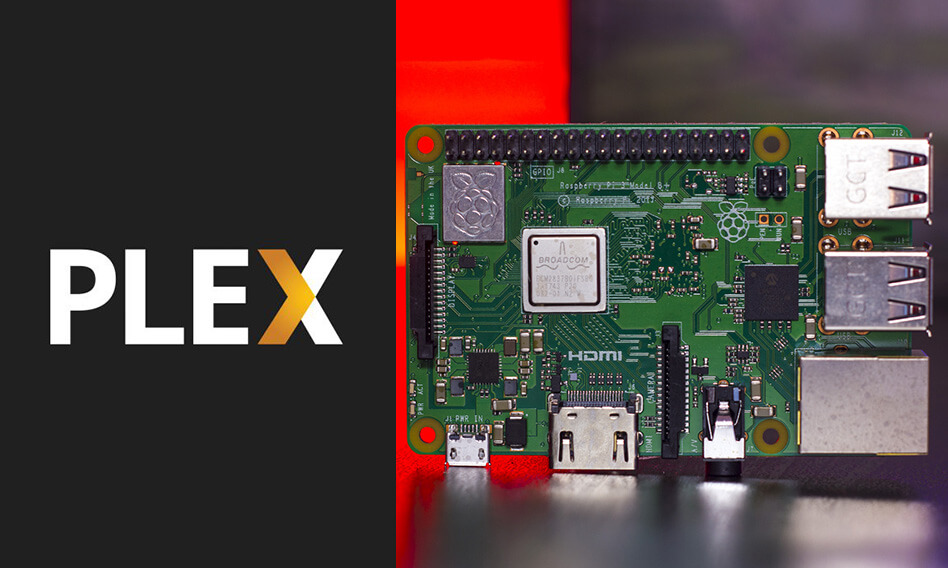When it comes to Plex on the Raspberry Pi, the more resources you can give it, the better it will perform. So in this guide, I will show you how to setup a light weight Raspberry Pi Plex Server with only a few steps!
Let’s get started!
Table of Contents
Hardware List
- Raspberry Pi 3B+ (Preferred), 3, 2 or 1
- USB Keyboard
- Wired or Wireless Internet Access
- Minimum 8GB MicroSD Card
Software List
- Latest Raspbian Stretch Lite Image
- Etcher
Step 1: Download and Install Raspbian Lite on Micro SD Card
First up you will need to download the latest Raspbian Lite image to your computer. Next you will need to download and install the software Etcher. Once this is done, open Etcher and choose the Micro SD Card to write to, choose the Raspbian Lite image you downloaded and then hit write and accept any warnings.
Step 2: Update and Upgrade Raspbian Lite
Let’s make sure we are running the latest version and have the latest repositories on hand by doing a quick update and upgrade of our Raspbian Lite installation.
sudo apt update
sudo apt upgrade
Step 3: Install the Transport HTTPS Package
The Transport HTTPS package is neccessary to install from HTTPS sources, so we need to make sure transport-https is installed.
sudo apt install apt-transport-https -y
Step 4: Add Necessary Repository to Raspbian Lite
Next we need to add some new repository sources to our Raspberry Pi so we can install Plex Media Server. Doing a quick update aftwards will ensure we have the Plex package in our list.
wget -O - https://dev2day.de/pms/dev2day-pms.gpg.key | sudo apt-key add -
echo "deb https://dev2day.de/pms/ stretch main" | sudo tee /etc/apt/sources.list.d/pms.list
sudo apt update
Step 5: Install Plex Media Server
Now that we have everything ready we can install Plex and do a quick reboot.
sudo apt install -t stretch plexmediaserver-installer -y
reboot
Step 6: Store Plex Metadata on a USB Hard Drive (Optional)
If you really want to be using a Raspberry Pi Plex Server, then you might want to consider using an external USB Hard Drive. With 1080p BluRay movies ranging in size, these can be as large as 8GB if not more. If you want to learn how to Auto Mount a Windows NTFS USB Hard Drive, then follow that link. Otherwise, feel free to skip this section.
Once you have rebooted and setup your NTFS Hard Drive on your Raspberry Pi, we need to create a new folder for Plex data so it doesn’t fill up the SD Card. Replace usbhdd with your mount point directory.
mkdir /mnt/usbhdd/plex-data
sudo cp -r /var/lib/plexmediaserver/Library/Application\ Support/Plex\ Media\ Server /mnt/usbhdd/plex-data
A quick check should reveal a folder called Plex Media Server which means it all copied across successfully.
ls -la /mnt/usbhdd/plex-data
Now we are going to create a symlink (or Symbolic Link which is kinda like a Windows Shortcut) so Plex Server can still read all the Plex data from the hard drive.
sudo ln -s /mnt/library/plex-data/Plex\ Media\ Server /var/lib/plexmediaserver/Library/Application\ Support/Plex\ Media\ Server
And finally, let’s check that the Symlink is in place and working. You should see the Plex Media Server directory.
ls -la /var/lib/plexmediaserver/Library/Application\ Support
Step 7: Connect to the Raspberry Pi Plex Server
Now we have everything setup on the Raspberry Pi, we need to login to the Plex Media Server from a Computer. This can be via the Raspberry Pi’s IP address which you can find by doing the following command.
hostname -I
Once you have that IP Address, jump over to your computers web browser and type in the following using your IP then colon 32400
192.168.1.xxx:32400/web/
Go through the login and setup prompts selecting which folders have Movies and which have TV Shows. In my case, it is under usbhdd/media/movies and usbhdd/media/tv when choosing sources.
Now through my testing, I found that Transcoding on a Raspberry Pi 3 B+ was a little hit and miss with 1080p files. So to combat this, I changed the section under Settings, Quality, Video Quality to Maximum. This greatly improved my h.264 encoded streaming from the Raspberry Pi using Plex. I wouldn’t recommend h.265 encoded files at this stage due to the amount of horsepower they require to decode. Now you will have a fully setup Raspberry Pi Plex Server ready to stream all your movies and tv media files!
